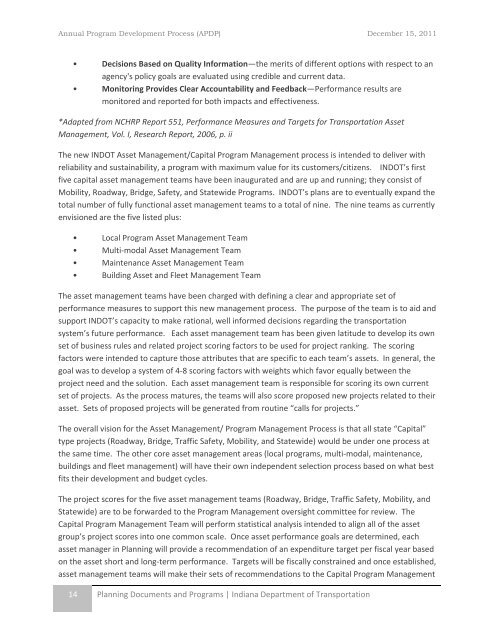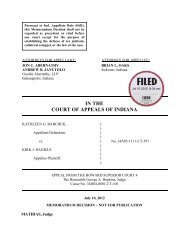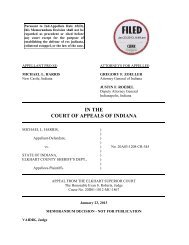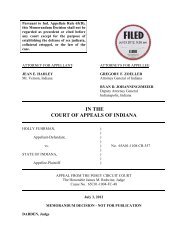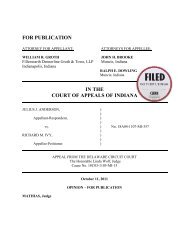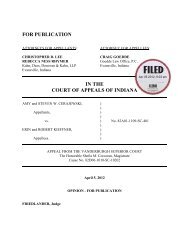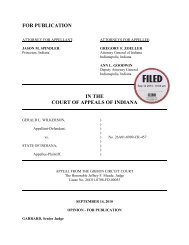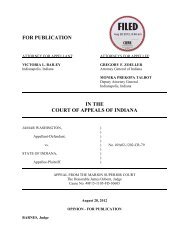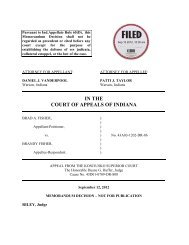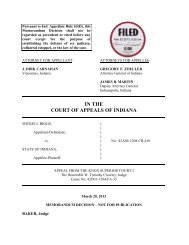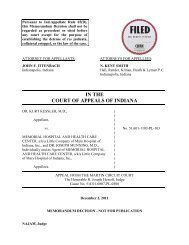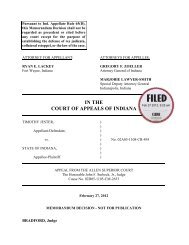Annual Program Development Process (APDP) - State of Indiana
Annual Program Development Process (APDP) - State of Indiana
Annual Program Development Process (APDP) - State of Indiana
You also want an ePaper? Increase the reach of your titles
YUMPU automatically turns print PDFs into web optimized ePapers that Google loves.
<strong>Annual</strong> <strong>Program</strong> <strong>Development</strong> <strong>Process</strong> (<strong>APDP</strong>) December 15, 2011<br />
• Decisions Based on Quality Information—the merits <strong>of</strong> different options with respect to an<br />
agency's policy goals are evaluated using credible and current data.<br />
• Monitoring Provides Clear Accountability and Feedback—Performance results are<br />
monitored and reported for both impacts and effectiveness.<br />
*Adapted from NCHRP Report 551, Performance Measures and Targets for Transportation Asset<br />
Management, Vol. I, Research Report, 2006, p. ii<br />
The new INDOT Asset Management/Capital <strong>Program</strong> Management process is intended to deliver with<br />
reliability and sustainability, a program with maximum value for its customers/citizens. INDOT’s first<br />
five capital asset management teams have been inaugurated and are up and running; they consist <strong>of</strong><br />
Mobility, Roadway, Bridge, Safety, and <strong>State</strong>wide <strong>Program</strong>s. INDOT’s plans are to eventually expand the<br />
total number <strong>of</strong> fully functional asset management teams to a total <strong>of</strong> nine. The nine teams as currently<br />
envisioned are the five listed plus:<br />
• Local <strong>Program</strong> Asset Management Team<br />
• Multi‐modal Asset Management Team<br />
• Maintenance Asset Management Team<br />
• Building Asset and Fleet Management Team<br />
The asset management teams have been charged with defining a clear and appropriate set <strong>of</strong><br />
performance measures to support this new management process. The purpose <strong>of</strong> the team is to aid and<br />
support INDOT’s capacity to make rational, well informed decisions regarding the transportation<br />
system’s future performance. Each asset management team has been given latitude to develop its own<br />
set <strong>of</strong> business rules and related project scoring factors to be used for project ranking. The scoring<br />
factors were intended to capture those attributes that are specific to each team’s assets. In general, the<br />
goal was to develop a system <strong>of</strong> 4‐8 scoring factors with weights which favor equally between the<br />
project need and the solution. Each asset management team is responsible for scoring its own current<br />
set <strong>of</strong> projects. As the process matures, the teams will also score proposed new projects related to their<br />
asset. Sets <strong>of</strong> proposed projects will be generated from routine “calls for projects.”<br />
The overall vision for the Asset Management/ <strong>Program</strong> Management <strong>Process</strong> is that all state “Capital”<br />
type projects (Roadway, Bridge, Traffic Safety, Mobility, and <strong>State</strong>wide) would be under one process at<br />
the same time. The other core asset management areas (local programs, multi‐modal, maintenance,<br />
buildings and fleet management) will have their own independent selection process based on what best<br />
fits their development and budget cycles.<br />
The project scores for the five asset management teams (Roadway, Bridge, Traffic Safety, Mobility, and<br />
<strong>State</strong>wide) are to be forwarded to the <strong>Program</strong> Management oversight committee for review. The<br />
Capital <strong>Program</strong> Management Team will perform statistical analysis intended to align all <strong>of</strong> the asset<br />
group’s project scores into one common scale. Once asset performance goals are determined, each<br />
asset manager in Planning will provide a recommendation <strong>of</strong> an expenditure target per fiscal year based<br />
on the asset short and long‐term performance. Targets will be fiscally constrained and once established,<br />
asset management teams will make their sets <strong>of</strong> recommendations to the Capital <strong>Program</strong> Management<br />
14 Planning Documents and <strong>Program</strong>s | <strong>Indiana</strong> Department <strong>of</strong> Transportation


